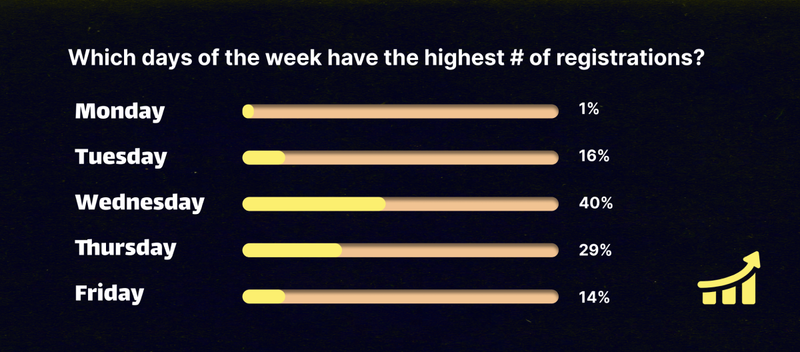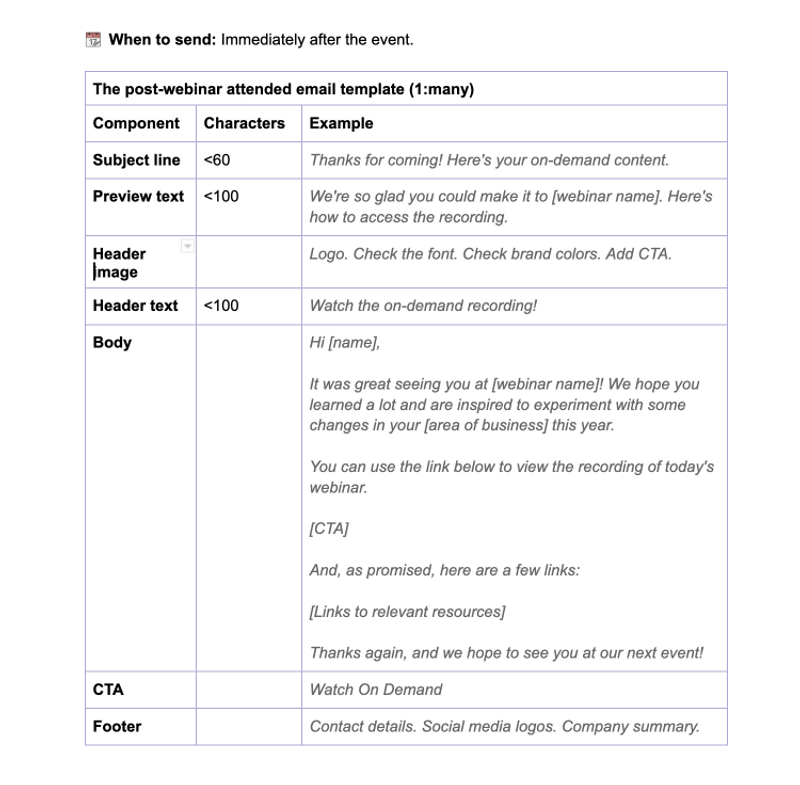Webinar Operations Checklist: Your One-Stop Webinar Planning Resource

Table of Contents
Maximize Your Marketing ROI
Join 10,000 other marketers already getting the best tips on running engaging events that boost pipeline and create raving fans.
Webinars have become a part of everyday life for event marketers across the globe.
But that doesn’t mean they’re easy. Behind every webinar, you’ll find countless hours of planning, loads of meticulous prep work, and one seriously productive event team.
Our webinar operations checklist is here to help you keep it all together. Use this all-one-one planning resource to make sure the right tasks are covered before, during, and after your next webinar.
The essential webinar operations checklist:
- Clarify your goal and purpose
- Define your target audience
- Choose the right date and time
- Test and select your webinar platform
- Create your registration page
- Build your content
- Recruit your speakers and moderator
- Run through your tech check
- Start promoting your webinar
- Start on time and set expectations
- Engage your attendees
- Record the webinar
- Send a follow-up email
- Evaluate your event KPIs
- Use your webinar data to inform future campaigns
Before the webinar
-
Clarify your goal and purpose
By pinning down “the big why” behind your webinar, you ensure all aspects of your event are in complete alignment.
From your webinar format and structure to your content, speakers, and networking activities — each and every element of your event should be pulling towards the same end goal.
A clear purpose for your webinar also makes it much easier to promote your event to potential attendees. With a firm answer to the proverbial “what’s in it for them?”, you’ll have all the material you need to boost your attendance numbers.
When defining the purpose and goal of your webinar, consider the following:
- What core pain point are you solving with your webinar?
- Which important industry topic or trend do your prospects need more information on?
- How will this webinar support the rest of your marketing strategy?
💡 Top tip: Use your event platform’s data reports to track and analyze your event KPIs.
-
Define your target audience
Understanding your target audience allows you to tailor your content and create a webinar that not only resonates — but keeps attendees coming back for more.
To start, here are a few questions to think about:
- What industries or sectors do you cater to?
- What size of companies would benefit most?
- Who are the key decision-makers?
- Where are they located?
💡Top tip: Webinars are awesome, but they’re just one part of a modern event strategy. With a clear picture of who you’re targeting, you can start to think about other event types that would cater to your audience beyond webinars.
-
Choose the right date and time
Show that you respect your attendees’ time by choosing a date and time that’s convenient for them. Remember, this will also go a long way in increasing the likelihood of them actually showing up to your webinar.
When choosing a date and time for your webinar, consider the following questions:
- What does your ideal attendee’s week typically look like?
- What specific geographical locations and time zones are you targeting?
- How can you make it easy for them to stop what they’re doing and join your webinar?
💡Top tip: Our research shows that Wednesday and Thursday are the most popular days to host a webinar, avoiding those hectic Mondays and Tuesdays, while accommodating those who work flexible Fridays.

-
Test and select your webinar platform
Companies average just slightly more than one webinar each month, with many reaching as much as 10X that number. You need an event platform that gives you all the right branding and customization features, while making it easy to replicate your events at scale.
Here are some of the top features to look for in an event platform:
- Customizable branding
- Key MarTech stack integrations
- Deep attendee-level data insights
- Wide range of engagement options
- Strong customer support
💡Top tip: Not sure which platform to choose? Check out customer wins and case studies to find out what other users have to say about their experience with the tool.
-
Create your registration page
Your webinar registration page is the homepage of your event. As the friendly face that greets your audience and entices them to sign up, it has got to look good.
Here are the elements to include in your webinar registration page:
- Clear and compelling headline/webinar name
- Concise description outlining the key takeaways and benefits
- Eye-catching visual elements - speaker headshots, video, custom logo
- Date, time, and duration - our research suggests under 30 minutes is best
- Clear call-to-action (CTA) button
💡Top tip: Keep things simple with a user-friendly registration page builder. And if your platform gives you the option, don’t forget to enable Slack + Salesforce integrations to see your registrations in real-time.
-
Build your content
You only get one chance to create stellar content for your webinar. Get it right, and that content can continue to drive traffic, leads, and engagement long after the event.
Make your webinar content epic by:
- Choosing an engaging topic
- Creating a clear outline (and sticking to it)
- Keeping it visually interesting
- Building in audience interaction
💡Top tip: Our research has found that 96% of attendees expect event content to be available on-demand, so be sure to grab a copy of your speaker slides and presentations.
-
Recruit your speakers and moderator
65% of business attendees say it’s the speakers that make a virtual event experience excellent. Focus on finding speakers that are relevant, engaging, and ready to knock the socks off your audience.
Then, set your speakers up to win using the following tools and resources:
- Done-for-you speaker guides
- Magic links for easy access
- One-step tech-checks
- Rich speaker profiles
- Ability to add, mute, and hide speakers as needed
- Private digital backstage area
- Multiple presentation layouts
- Multiple speaker layouts
- Virtual speaker backgrounds
- Shareable speaker resources
- Easy screensharing
💡Top tip: Invite speakers to an exclusive backstage area via a magic link where you can introduce them to the moderator, show them around the platform, and prepare them for a standout session.

-
Run through your tech check
Always work with your moderator and speakers to run through your tech check before the event and avoid those awkward ‘can you see my screen?’ moments.
Here are the AV essentials to cover:
- High-speed internet connection
- Reliable computer/laptop and charger
- Well-lit quiet environment
- Quality webcam and microphone
💡Top tip: Grab our free Event Production AV Guide to keep the process smooth and seamless.
-
Start promoting your webinar
Now that you’re crystal clear on who you’re targeting with your webinar, you should also know exactly where to find them.
Here are some of the most effective channels for promoting your webinar:
- Social media
- Partner and influencer collaborations
- Communities and newsletters
- Employee networks
- Content snippets on website and email signatures
💡Top tip: Make sure your webinar promos stand out from the crowd. From GIFs to live streams, celeb cameos and attendee incentives, don’t be afraid to get creative!
During the webinar
-
Start on time and set expectations
Your attendees’ time is gold. Respect it by starting on time. (And don’t worry about late-comers, they’ll catch up. 😉)
Kick off with some quick housekeeping to answer top attendee FAQs upfront, including:
- The agenda for the webinar
- What you’re hoping attendees will get out of the event
- If the session will be recorded and where to find the recording
- What to do if they have a question/where the chat is located
- What to do if they need to leave in the middle of the webinar
💡Top tip: Set up a dedicated Slack channel where tech problems can be directed in case anyone has trouble accessing the webinar.

-
Engage your attendees
Attendee engagement is crucial to your webinar success. No matter how your webinar agenda is structured, look for ways to provide real-time feedback and get the audience involved.
Here are some of the top engagement features to use in your webinar:
- Live polls
- Text and video Q&A
- Chats, GIFs & private chats
💡Top tip: Hosts and moderators can use your platform’s analytics dashboard to track activity triggers in real-time.
-
Record the webinar
Always make sure you record your webinar so it can be used in follow-ups and as evergreen on-demand content.
Here are a few ways to ensure a quality webinar recording:
- Enable captions or translations ahead of time
- Inform attendees from the start that the webinar will be recorded
- Prepare a dedicated event hub where you can upload recordings post-event
💡Top tip: You have a lot to remember on the day. For one less thing to worry about, choose an event platform that records by default.
After the webinar
-
Send a follow-up email
With your webinar recorded, it’s time for the post-event follow-up. While it can be tempting to skip this step, the good news is most of the follow-up process can be planned and automated for easy post-event execution.
Here are some best practices to help you nail your webinar follow-up:
- Use your event data to segment attendees
- Create targeted follow-up for ‘attended’, ‘didn’t attend’ and ‘no show’
- Set your subject line apart
- Share the recording
- Include images or a video snippet
💡Top tip: If your event platform gives you deep data insights, use them in your follow-ups. For example: “I can see you asked a question about XYZ. I’d be happy to show you how we solve that with a quick product demo.”

-
Evaluate your event KPIs
When it comes to events, it literally pays to know your ROI. To make sure you’re improving with each new webinar you host, always be sure to track your event KPIs.
Use the data in your event platform to pinpoint your:
- Registration numbers
- Attendance rate
- Number of new leads
- Time spent in event
- Engagement score
- Pipeline sourced or influenced
💡Top tip: Use this data to run a webinar post-mortem. Prove your ROI, identify opportunities for improvement, and don’t be afraid to ask for future investment for a winning webinar strategy.
-
Use your webinar data to inform future campaigns
Attendee data isn’t just about proving your ROI (although that is a big part of it). It can also help you assess audience behavior and plan future high-ROI campaigns.
Here are some things to look for in your event data:
- When and where engagement spiked
- What topic was being discussed
- Which speakers had the most engagement
💡Top tip: With cross-event reporting you can get a holistic performance view across your entire webinar series, identifying best practices, trends, and other key patterns in your data.
Webinar success? Check ✅
When it comes to acing your webinar operations, there’s a lot to consider.
But with a clear plan and the right event platform to back it up, you’ll have everything you need to knock your next webinar out of the park.
At Goldcast, our mission is to help you build a modern event strategy that is repeatable, engaging, and actionable. Our platform was purpose-built to help event marketers set up webinars in hours, not weeks.
![[object Object]](https://cdn.sanity.io/images/2939l4aj/production/4b567f3dddf1e73c8087dbf8426c8ac19f9a351e-1200x350.png?w=800)
Stay In Touch
Platform
Resources
Company
Community
© 2025 Copyright Goldcast, Inc. All rights reserved.



 Upcoming Events
Upcoming Events Event Series
Event Series On-Demand Events
On-Demand Events

